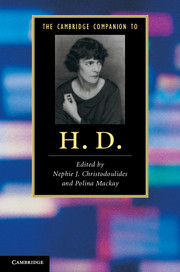11 - Reading history in The Gift and Tribute to Freud
from PART II - WORKS
Published online by Cambridge University Press: 28 November 2011
Summary
Past, present, future, these three – but there is another time-element, popularly called the fourth-dimensional . . . This fourth dimension, though it appears variously disguised and under different subtitles, described and elaborately tabulated in the Professor’s volumes . . . is yet very simple. It is as simple and inevitable in the building of time-sequence as the fourth wall to a room.
By the end of the Second World War, H.D. had come to understand her writing – both poetry and prose – as prophetic. She was to mine her unconscious, her personal and family history, and Moravian American history generally, to point the way towards a future of peace built on a religious syncretism in which women's role was at least equal to that of men. The promise of that peaceful future was ‘written’ in history for those who knew how to read it – visionaries such as herself who had a divinely inspired ‘Gift’. Psychoanalysis, H.D. believed, offered the tools she needed to access her gift for historical interpretation, but she also believed that her interpretive gift was a mystical inheritance passed down through her maternal Moravian ancestry.
In The Gift and Tribute to Freud, the relationship between history and psychoanalysis is a symbiotic one. In both works, H.D. uses psychoanalysis to ‘read’ history the way a fortune-teller reads cards – an analogy she uses several times in Tribute to Freud and a plot-sequence she invokes in the second chapter of The Gift, ‘Fortune Teller’. H.D. derived from Freud’s The Interpretation of Dreams her understanding of the ‘fourth dimension’ as a ‘universal consciousness’ outside time (Tribute, p. 71), with the precise form that consciousness might take at any given moment determined by particularities of time and place (or socio-historical space), and inflected with personal specificities.
- Type
- Chapter
- Information
- The Cambridge Companion to H. D. , pp. 159 - 173Publisher: Cambridge University PressPrint publication year: 2011

